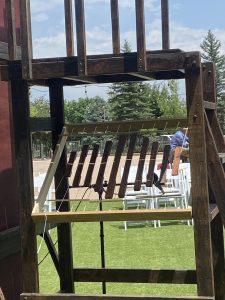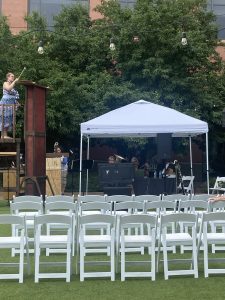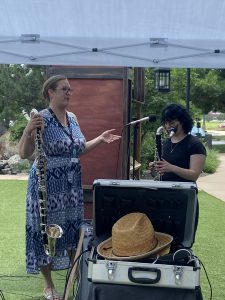
ClarinetFest® 2023 in Review
ClarinetFest® 2023 Day 2
Masterclass and Demonstration, Natalie Szabo
by Julia Lougheed
On Thursday afternoon, I walked out to the South Courtyard of the Westin hotel to see Natalie Szabo and some of her colleagues standing around what looked like a giant, wooden contraption out of a Dr. Suess book. Natalie introduced herself and her colleagues William “Jason” Raynovich and Rebecca Reinecke, and explained that the Dr. Seuss-like contraption was a Harry Partch pitched instrument, integral to a performance of “tré”.

“Tré” is essentially an installation, thematically about the passage of time and the ever-changing soundscape of a given location. This piece was also partly inspired by John Cage’s “10,000 Things”. To play “tré”, musicians read pitches off of a computer screen and play these sounds into a microphone. All pitches notated on the computer screen are accompanied by tuning instructions, telling players to tune notes a certain number of cents sharp or flat (nothing is set at A= 440). A computer program then processes these pitches, adding distortion to these sounds and altering the pitches in an effort to bring all notes sounded to A = 440. However, the notes never quite make it there – they just get close. This aspect, combined with the distinctive sounds and tunings of the Harry Partch percussion instruments, gives the piece an otherworldly, timeless quality to it.
During the masterclass and demonstration of “tré”, William “Jason” Raynovitch and Rebecca Reinecke shared that they first conceived of this piece while in residence at Art Barn School of Art. Reinecke spoke of the serendipitous partnership that emerged during this residency, “Jason and I were interested in similar artistic ideas – and he was a musician while I liked to build things, so it just happened!” The sense of whimsy involved with the creation of this work came through while Jason and Natalie spoke about this piece as well. Jason encouraged audience members to come up and try to play a short iteration of this work, “You can totally try – it’s okay, you can’t play a wrong note!” Natalie spoke about how learning this piece and staging it with other classically trained clarinetists was a bit of a challenge because of this aspect. “This throws everyone a bit,” she said, “even new music people – it’s like ‘okay, I’m good, it’s free, but I’m so afraid to play some of these tunings because I might squeak’.” Unlike many of the pieces presented at ClarinetFest, squeaks in this piece are welcome. “This is about nature, and how nature always wins”, Jason commented, “A squeak in the sound will be processed and played back out, but it kind of becomes a scar in the bark of a tree – just a little element that makes this specific performance stand out a bit.”

“Tré” is structured in four movements, each one named after and embodying characteristics of one of the four seasons. Natalie encouraged and helped several clarinetists and one tuba player play through “Summer”, “Autumn”, and “Spring“ during her demonstration. As the players cycled through the seasons, you could hear some of the earlier musical ideas performed played back after being altered by the computer processor. When an audience member shared this observation, Natalie commented that this is one of special quirks of the piece – it plays older material back to the audience on a slow-moving loop. Natalie also mentioned that this piece is typically intended for long-form performances, and that the most fulfilling one she had been part of lasted for 72 hours. “It’s great because you step up, play a bit, and then come back the next day and you’re like, “Oh! Those are still my sounds!’ “.

After this masterclass and demonstration, Natalie, Jason, and Rebecca set up for a 45-minute performance of this work, featuring bass clarinetist Lara Mitofsky Neuss and contrabass clarinetist Jason Alder. I stayed for the performance and was deeply moved. Rebecca Reinecke sang a short melody during this performance; her soprano voice mixed with Harry Partch percussion and low clarinets created a compelling sound world. A particularly special moment happened when all musicians had walked away from the performance site, but their sounds were still being played. With the previously struck keys of the Harry Partch instruments in sight, but empty, this gave a ghostly effect, and left the audience feeling as though this music belonged to the outdoors more so than it belonged to any one human being.
Comments are closed.